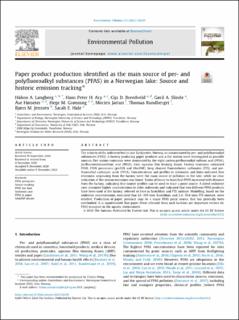Paper product production identified as the main source of per- and polyfluoroalkyl substances (PFAS) in a Norwegian lake: Source and historic emission tracking
Langberg, Håkon Austad; Arp, Hans Peter; Breedveld, Gijs D.; Slinde, Gøril Aasen; Høisæter, Åse; Grønning, Hege Mentzoni; Jartun, Morten; Rundberget, Thomas; Jenssen, Bjørn Munro; Hale, Sarah
Peer reviewed, Journal article
Published version
Permanent lenke
https://hdl.handle.net/11250/2756115Utgivelsesdato
2020Metadata
Vis full innførselSamlinger
- NGI articles [1061]
Sammendrag
The entirety of the sediment bed in lake Tyrifjorden, Norway, is contaminated by per- and polyfluoroalkyl substances (PFAS). A factory producing paper products and a fire station were investigated as possible sources. Fire station emissions were dominated by the eight carbon perfluoroalkyl sulfonic acid (PFSA), perfluorooctanesulfonic acid (PFOS), from aqueous film forming foams. Factory emissions contained PFOS, PFOS precursors (preFOS and SAmPAP), long chained fluorotelomer sulfonates (FTS), and perfluoroalkyl carboxylic acids (PFCA). Concentrations and profiles in sediments and biota indicated that emissions originating from the factory were the main source of pollution in the lake, while no clear indication of fire station emissions was found. Ratios of linear-to branched-PFOS increased with distance from the factory, indicating that isomer profiles can be used to trace a point source. A dated sediment core contained higher concentrations in older sediments and indicated that two different PFAS products have been used at the factory, referred to here as Scotchban and FTS mixture. Modelling, based on the sediment concentrations, indicated that 42e189 tons Scotchban, and 2.4e15.6 tons FTS mixture, were emitted. Production of paper products may be a major PFAS point source, that has generally been overlooked. It is hypothesized that paper fibres released from such facilities are important vectors for PFAS transport in the aquatic environment.
